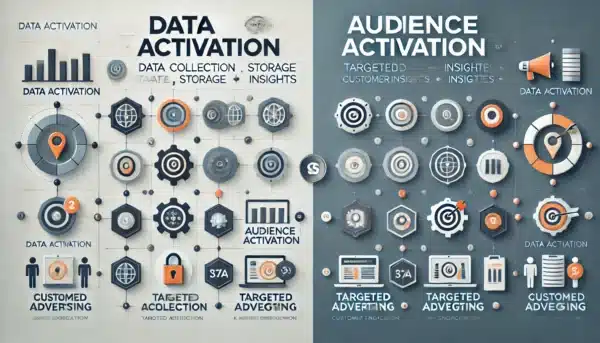
Published, February 04, 2025
Data is the foundation of modern retail media, enabling businesses to optimize operations and create meaningful customer engagements. Data activation plays a critical role in transforming raw data into actionable insights, while audience activation focuses on using that data to engage target customers in real-time.
Understanding the differences between data activation and audience activation is essential for leveraging both strategies effectively. This article explores their unique roles in retail media, their intersection, and how businesses can implement the right approach for maximum impact.
What is Data Activation?
Businesses collect vast amounts of first-party data from sources such as purchase history, loyalty programs, surveys, mobile apps and website activity But without activation, this data remains untapped. Data activation is the process of transforming raw data into meaningful data points that businesses can use for decision-making, targeting, and optimization across marketing, operations, and analytics. It ensures that first-party data s accessible and usable for decision-making.
How Data Activation Works
Consented data is collected and securely stored according to privacy and data management regulations, ensuring proper audience consent and adherence to industry standards. Once processed, the data can be used to refine marketing strategies, optimize in-store experiences, and improve customer engagement. A data activation platform processes and integrates data across different systems, enabling businesses to:
- Clean and unify customer data for accurate insights.
- Automate workflows across retail media networks and digital advertising.
- Analyze store traffic and footfall data to optimize product placements and in-store marketing.
Retailers leveraging first-party data activation can enhance audience engagement and improve marketing efficiency. Google’s First-Party Data Playbook highlights how brands are increasingly turning to data activation for competitive advantage.
What is Audience Activation?
Unlike data activation, which focuses on making data usable, audience activation is about using that data to reach and engage specific audience segments. This strategy enables real-time tailored content and ensures marketing efforts align with consumer interests and needs.
In retail media, audience activation powers in-store digital experiences, such as dynamic digital signage that adapts the content based on who’s present in the store or in front of a screen. Advertisers can deliver contextually relevant content and measure engagement in real-time.
For a deeper look into audience activation, explore our in-depth guide on what is audience activation and its role in shaping retail media strategies
Key Differences Between Data Activation and Audience Activation

While both concepts are interconnected, they serve different purposes in retail media strategy:
Scope
- Data Activation: Encompasses all data types, including operational, audience, and product data.
- Audience Activation: Focuses on using audience data for targeting, engagement and marketing purposes.
Goals
- Data Activation: Ensures data is structured, accessible, and actionable across systems (e.g., CRM, analytics, dashboards).
- Audience Activation: Uses audience segmentation to deliver tailored messaging and engagement strategies.
Examples in Retail Media
- Data Activation Example:
- Online: Analyzing eCommerce purchase patterns to suggest relevant product recommendations on a retailer’s website.
- In-Store: Using foot traffic analytics to determine high-traffic zones in a store and optimize product placement accordingly.
- Audience Activation Example:
- Online: Displaying personalized product ads on programmatic ad networks based on browsing history and past purchases.
- In-Store: Using digital signage to deliver advertising that adjusts in real-time based on the demographics of shoppers in front of the screen.
Unraveling audience activation in advertising provides additional insights into how data and audience activation are reshaping media strategies.
Why Do Both Matter for In-store Retail Media?
Data activation and audience activation are complementary strategies that work together to maximize target audience reach and marketing efficiency.
For example:
- Data activation processes in-store traffic data collected in real-time.
- Audience activation applies those insights to deliver customized in-store experiences, such as tailored promotions displayed on digital screens.
This synergy ensures that retailers make data-driven decisions while optimizing in-store engagement. DIGIDAY’s insights highlight how businesses are streamlining data activation for better marketing outcomes.
Use Cases for Data and Audience Activation in In-store Retail Media
Data Activation Use Cases
- Tracking footfall traffic to identify peak shopping hours.
- Optimizing store layouts based on customer movement patterns.
Audience Activation Use Cases
- Displaying real-time promotions based on shopper demographics and past behavior.
- Running dynamic in-store campaigns that adjust content according to real-time shopper interactions.
- Retailers can use dynamic audience activation platforms to enhance in-store engagement, ensuring that campaigns reach the right audience at the right time.
Choosing the Right Strategy for Your Business

Not every business has the same needs, so understanding where to prioritize investment is key:
- Retailers focusing on operational efficiency should invest in data activation to streamline store operations and improve inventory management.
- Retailers aiming to increase customer engagement should focus on audience activation to deliver relevant in-store experiences and targeted promotions.
For in-store retail media, cutting-edge solutions like Advertima Audience AI enable real-time data and audience activation, performance measurement and improved shopper engagement.
FAQ: Data Activation vs Audience Activation
1. Can data activation exist without audience activation?
Yes. Data activation involves organizing and structuring all types of data—not just audience data. Businesses can activate operational and product data without directly engaging customers.
2. Does audience activation always require first-party data?
Not necessarily. While first-party data activation enhances audience activation, some strategies use contextual signals or third-party data to engage audiences dynamically.
3. How does audience activation improve retail media performance?
By leveraging real-time audience insights, retailers can optimize digital signage content, ensuring shoppers receive relevant promotions and product recommendations.
4. How does Advertima’s technology align with audience activation?
Advertima Audience AI processes real-time shopper data to deliver customized in-store experiences, ensuring marketing campaigns align with shopper behavior and demographics.
Conclusion
Both data activation and audience activation are essential for optimizing retail media strategies. While data activation ensures data is structured and accessible, audience activation transforms that data into meaningful customer interactions.
To explore audience engagement strategies further, check out our article on audience activation and its crucial role in retail media.
